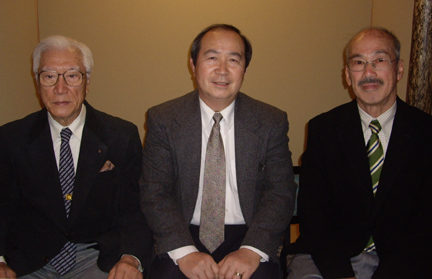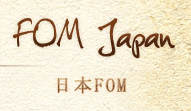Gates Ajar – Spring 2009
Saturday, March 21st, 2009A Pilgrimage to Nagasaki to Meet Obama-san
January 20, 2009 was indeed an historic day, not only for Americans, but also for many people all over the world. On that day a “New Era” started with the inauguration of the new President of the United States of America, Barack Obama, in Washington D.C. But where was I on that day? I was sitting next to another Mr. Obama at a dining table in a Chinese Restaurant in the ANA Nagasaki Hotel in Japan. This white-haired gentleman – about 40 year’s Barack Obama’s senior – was Dr. Masami Obama (83), a gynecologist and obstetrician of Nagasaki City in Japan. Perhaps I need to, 1) introduce who this Japanese Obama-san is, and, 2) explain why I was meeting with him in Nagasaki on January 20, 2009.

[left to right: Dr. Obama, Mas Yatabe, Mr. Minoru Maeda]
Dr. Obama has been an active Rotarian for many years and was president of Rotary Club Nagasaki South Chapter in 1988. He was the first Chairman of FOM Nagasaki as well, which was formed on March 6, 1998 [FOM in America’s official organization date was May 20, 1988]. Dr. Obama was the force behind the effort to erect the impressive granite monument of Ranald MacDonald not too far from Dejima in Nagasaki in 1994 as the commemoration of their 30th anniversary of the Chapter.
As I stood across from Ranald MacDonald’s monument in front of this rather large, well-fenced house where the make-shift prison “Daihian” used to be [the so-called jail house “Daihian” stood less than a 10-minute walk from Dejima Island on the way to Matsunomori Shrine near the famous Great Suwa Jinja], I could not help but imagine Moriyama Einosuke [who would later become chief interpreter for the Tokugawa Shogunate] and 13 other native-Japanese Dutch/Japanese interpreters walking into the house to take English lessons from a native English speaker for the first time in Japanese history. What a significant event that was! The year was 1848 [a full 5 years before Commodore Perry of the East India Fleet of America came to the Uraga port with 4 black ships with a demand that Japan open its doors to American vessels] and a native Oregonian, Ranald MacDonald, was the teacher. Many historians, including Mr. Akira Yoshimura, the author of “Umi-no-Sairei” [Festival of the Sea)] believe the English lessons at Daihian influenced the outcome of the negotiations between the Tokugawa Shogunate and Commodore Perry of the United States of America, which took place several years later. The ability of the native Japanese interpreters to understand and speak English and their knowledge of the current events of the world impressed the American negotiators and raised their level of respect for the Japanese negotiators.
Along my journey to Nagasaki to meet with Dr. Obama and visit the Ranald MacDonald Monument, I met several other remarkable Friends of MacDonald in Japan, and I would like to introduce them to our members (in no particular order):
Mr. Yuji Aisaka of Kyoto is an ex-English teacher and an absolutely amazing person. Mr. Aisaka was present at the dedication ceremony of Ranald MacDonald’s birth place monument in Astoria in 1988. He has also visited MacDonald’s grave in Toroda, Washington. He attended and observed the Shinto-style dedication ceremony of the Monument of Ranald MacDonald in Nagasaki in 1994. Moreover, Mr. Aisaka searched out and visited the house where Ranald MacDonald’s father, Archibald McDonald, lived in Scotland! Mr. Aisaka is perhaps the most knowledgeable and enthusiastic friend of MacDonald around. He has given me books, newspaper clippings, a DVD, a video, etc., all related to MacDonald – and even reference material of Otokichi of Mihama. He says he is in love with the Columbia River – and I believe him!
Mr. Tetsuya Sano of Kobe, a former Hyogo State Representative and one of the Executives of the Hyogo Scouts Association was a leader of the Hyogo Boy Scouts when they erected the Sankichi “Friendship” monument at Fort Vancouver in Washington State in 1989. He and I traveled together with Mayor Koichi Saito and 107 citizens of Mihama in 1997 to the Makah Indian Reservation at Neah Bay, Washington, to follow in the footsteps of Sankichi in the Pacific Northwest. Mr. Sano presented me with a very interesting book written by the late Akira Yoshimura who authored a book about Ranald MacDonald’s venture into Japan called “Umi no Sairei” [Festival of the Sea]. The book I was given included the episodes behind the book and the research journals of the book Umi no Sairei.
Mr. Minoru Maeda, is a retired English teacher who lives in Nagasaki. Mr. Maeda was at the dinner with Dr. Obama on January 20th and he was the gentleman who kindly guided me around in Nagasaki to MacDonald’s monument, the historic Dejima, the China town and to the splendid Nagasaki Museum of History and Culture. Mr. Maeda said that in 1988 he was inspired by an article about MacDonald written by Richard Reed of The Oregonian, who was at that time a staff writer for the Daily Yomiuri newspaper. Mr. Maeda holds a Masters degree from University of Oregon and lived in the Eugene area with his wife and children for 2 and a half years in the 1980s and has many fond memories of Oregon.
Ms. Maiko Midorikawa had just returned from her honeymoon in Tahiti when I met her in Yokohama. Maiko-san was the ‘go-between’ between myself and Dr. Obama prior to my visit to Nagasaki. She is a graduate of Nagasaki University and thoroughly enjoyed the 3 months she spent a short while ago in the Portland area as a Nagasaki Rotary Club exchange student.
A little more on Dr. Masami Obama (83), the head of Obama Clinic, who is a true gentleman. He is quite active not only in his profession, but in Rotary club and other civic activities as well. I heard he is an avid golfer who just missed shooting his age by 1 stroke last year. I would like Dr. Obama to come and visit us and enjoy golfing in the Pacific Northwest in the near future.
Mr. Motohisa Shiota of Nagasaki, is another MacDonald enthusiast who was originally scheduled to be at the dinner with Dr. Obama and myself on January 20th, but his health did not allow him to come that day. I hope he is feeling better by now and that I can meet him here or in Japan some day.
Mr. Eiji Nishiya, is an Executive Director of FOM, Hokkaido. I was only able to speak with Mr. Nishiya on the phone while I was in Japan, but on my next trip to Japan, I am hoping to visit him in Rishiri, Hokkaido and to see the monument that stands near the beach where young MacDonald set foot on Japanese soil for the first time in 1848.
Ms. Yumiko Kawamoto of Tokyo, a noted scholar of not only MacDonald, but of all the historical figures and events leading up to the closure of Tokugawa Shogunate era.
I saw Ms. Kawamoto in November, 2008, but regretfully, we were not able to get together this past January. However, her advice on the phone prior to my pilgrimage to Nagasaki was invaluable. Ms. Kawamura was a guest speaker at the Oregon Historical Society in Portland in 2004 along with Frederik L. Schodt who authored a book of Ranald MacDonald called “Native American in the Land of the Shogun”.
I might add that during my journey to Nagasaki I was able to recruit two gentlemen to join us as “International members” of our own FOM. They are Mr. Yoshio Kojima and Mr. Fuminori Marumoto. Mr. Kojima, a graduate of Portland State University in the early1970’s, is a retired English teacher living in Tatebayashi, Gunma. Mr. Marumoto is president of Kumamoto Kenmin Department Store Ltd. and visited Portland twice in 2007. Kumamoto being not too far from Nagasaki, Mr. Marumoto was quite eager to learn more about Ranald MacDonald.
The most regrettable and truly disappointing thing during my trip to Nagasaki was during my visit to the Nagasaki Museum of History and Culture. In this new, $86 million museum [which was completed in 2005] – a wonderful and first class museum by any definition – nowhere did I find even a single mention of “Ranald MacDonald”. My feelings of disappointment in the Museum’s presentation [or lack thereof] were compounded when I had the opportunity to view a video of the dedication ceremony of the MacDonald monument in 1994 [given to me by Mr. Aisaka after I came back to Portland.] The dedication ceremony was attended by many of the local government, educational and civic leaders of the Nagasaki area then. Even the Honorable Consul Donald Y. Yamamoto from the US Consulate in Fukuoka was there to give a congratulatory speech – because Ranald MacDonald was a significant figure in the early days of the US-Japan relationship. How unfortunate that MacDonald’s contribution is completely overlooked by the Museum of History and Culture – a perfect stage to preserve the story of the first native-English-speaking English teacher to Japan if there ever was one.
The closest thing to any reference that the museum had was “… in 1858, the first English School was opened …” But that event was a full 10 years after Ranald MacDonald was brought to [and subsequently left] Nagasaki! I sincerely hope that Dr. Obama and other MacDonald enthusiasts can do something about this gaping hole. My understanding is that the Tokugawa Shogunate had given official permission to have such a class at Daihian in Nagasaki. It should at least be mentioned somewhere within the museum that in 1848, Ranald MacDonald of Oregon Territory taught the first English to the 14 professional Dutch/Japanese interpreters of Dejima.
I must say that the time I had allocated to spend in Nagasaki on this trip was far too short. My original intention was to meet with and pay my respect to Dr. Obama and to see the Ranald MacDonald Monument and then turn around and go back to Tokyo. I will know better the next time, for sure.







